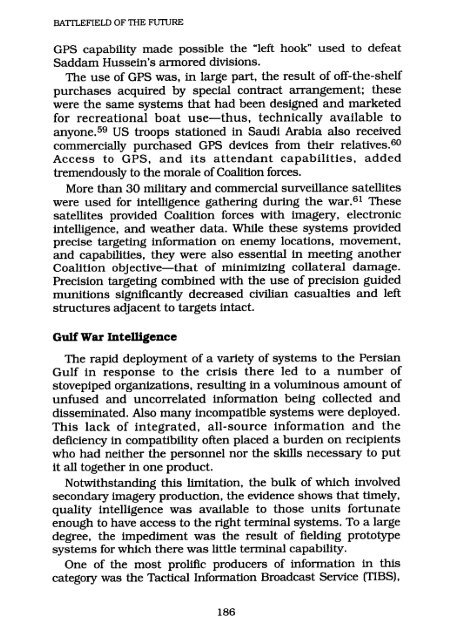BATTLEFIELD OF THE FUTURE
Battlefield of the Future - Air University Press
Battlefield of the Future - Air University Press
Create successful ePaper yourself
Turn your PDF publications into a flip-book with our unique Google optimized e-Paper software.
<strong>BATTLEFIELD</strong> <strong>OF</strong> <strong>THE</strong> <strong>FUTURE</strong><br />
GPS capability made possible the "left hook" used to defeat<br />
Saddam Hussein's armored divisions .<br />
The use of GPS was, in large part, the result of off-the-shelf<br />
purchases acquired by special contract arrangement ; these<br />
were the same systems that had been designed and marketed<br />
for recreational boat use-thus, technically available to<br />
anyone .59 US troops stationed in Saudi Arabia also received<br />
commercially purchased GPS devices from their relatives . 6 o<br />
Access to GPS, and its attendant capabilities, added<br />
tremendously to the morale of Coalition forces .<br />
More than 30 military and commercial surveillance satellites<br />
were used for intelligence gathering during the war .61 These<br />
satellites provided Coalition forces with imagery, electronic<br />
intelligence, and weather data . While these systems provided<br />
precise targeting information on enemy locations, movement,<br />
and capabilities, they were also essential in meeting another<br />
Coalition objective-that of minimizing collateral damage .<br />
Precision targeting combined with the use of precision guided<br />
munitions significantly decreased civilian casualties and left<br />
structures adjacent to targets intact .<br />
Gulf War Intelligence<br />
The rapid deployment of a variety of systems to the Persian<br />
Gulf in response to the crisis there led to a number of<br />
stovepiped organizations, resulting in a voluminous amount of<br />
unfused and uncorrelated information being collected and<br />
disseminated . Also many incompatible systems were deployed .<br />
This lack of integrated, all-source information and the<br />
deficiency in compatibility often placed a burden on recipients<br />
who had neither the personnel nor the skills necessary to put<br />
it all together in one product .<br />
Notwithstanding this limitation, the bulk of which involved<br />
secondary imagery production, the evidence shows that timely,<br />
quality intelligence was available to those units fortunate<br />
enough to have access to the right terminal systems . To a large<br />
degree, the impediment was the result of fielding prototype<br />
systems for which there was little terminal capability .<br />
One of the most prolific producers of information in this<br />
category was the Tactical Information Broadcast Service (TIBS),<br />
186

















